What are the forces at work reshaping the way brands and marketers connect with today’s consumers? The next decade of marketing innovation will be driven by the emerging technology piquing consumer, brand, and investor interest today: new mediums of storytelling unlocked by mixed-reality, new methods of communicating powered by social commerce, and problems to pre-empt driven by convergent social forces and the enduring digital acceleration.
Stagwell is all about transforming marketing – and we’re spending the year working with our agencies to explore how the most innovating and compelling opportunities in new frontiers will transform the way brands and marketers do business.
We’ll…
explore the practical, helping you understand things like if and how your brand should integrate virtual influencers in digital marketing efforts.
probe the conceptual…with questions like what responsibility brands have as they begin to imagine marketing and brand identity in space?
offer strategies for making sense of the monumental…with perspectives on how and when brands should get involved in the bourgeoning metaverse.
Meet Marketing Frontiers – Stagwell’s new content series that will unpack these blue-sky ideas before today’s brands, simplifying the future and helping leaders understand how these concepts will change the way we do business today and tomorrow.
Originally released on
CONTACT
Lorem Ipsum
FEATURING
Related
Articles
In the News, Marketing Frontiers, Press Releases, Stagwell Marketing Cloud
Apr 02, 2025
The European Commission Expands its Partnership with UNICEPTA by PRophet to Include Media Analysis

Artificial Intelligence, In the News, Marketing Frontiers, Press Releases
Apr 02, 2025
Stagwell (STGW) Appoints John Kahan as Inaugural Chief AI Officer

Artificial Intelligence, Artificial intelligence, Augmented Reality, Marketing Frontiers
Mar 03, 2025
Twister AIR: Revolutionizing a Classic with AR and AI-Driven Gameplay
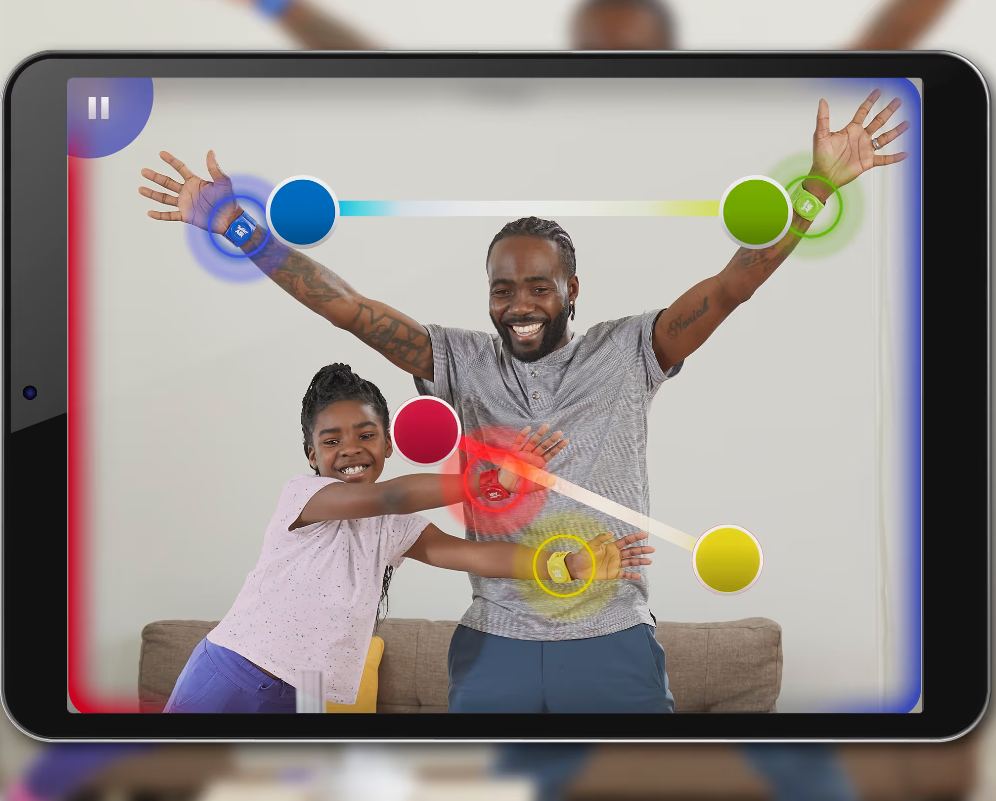
Newsletter
Sign Up
Originally released on
CONTACT
John Gerzema
FEATURING
A study conducted on behalf of Protocol by the Harris Poll found that while most U.S. adults have not used augmented reality or virtual reality technology, a notable portion are interested in trying AR and VR. The study also found younger U.S. adults were more familiar with the metaverse than older U.S. adults, and that Americans are unsure about the future of the metaverse’s regulation.
While most U.S. adults have not used AR or VR tech, many are still interested in adopting the technology. Early adopters of AR and VR tech skew younger.
Three quarters (72%) of U.S. adults have not used any augmented reality technology.
Currently, 16% of U.S. adults have not heard of AR technology. Part of this may be due to current product hesitancy or disinterest: only a quarter (25%) of U.S. adults have no interest in using AR technology. On the other hand, younger adults are more willing to embrace AR, especially Millennials. One in three (32%) Millennials currently uses AR technology (compared to 23% of Gen Z, 14% of Gen X, 6% of Baby Boomers).
Although more hesitant, other “young” generations are also open to AR. 38% of Gen Z and 38% of Gen X have not used AR technology, but say they are interested in doing so.
Two-thirds (68%) of U.S. adults have not used any virtual reality technology.
Currently, 12% of U.S. adults have not heard of VR technology. Hesitancy and disinterest in VR is similar to AR. Again, just a quarter (26%) are not at all interested in trying VR. Youth interest is also higher for VR. Three in five (61%) Gen Zers and 45% of Millennials have used VR technology at least once (compared to just 31% of Gen X and 10% of Boomers).
Users of AR and VR technology have had enjoyable experiences with some of the more common products. The most used VR and AR technologies are:
VR headsets (e.g., Oculus, HTC Vive) (61% used; of those, 88% had a positive experience)
Mobile VR apps (33% used; of those, 66% had a positive experience)
AR social media tools (31% used; of those, 81% had a positive experience)
VR motion controllers (e.g., standard hand controllers, wands, wheels) (30% used; of those, 77% had a positive experience)
Unsurprisingly, younger people are more familiar with the metaverse than their older counterparts. Younger people also say more often that the metaverse will enrich their lives.
Two in three (62%) U.S. adults said they were not familiar with the concept of the metaverse before taking this survey.
That said, younger generations are more familiar with the metaverse. 55% of Gen Z and 60% of Millennials are at least somewhat familiar with the concept of the metaverse (compared to just 35% of Gen Xers and 17% of Boomers).
Regardless of familiarity levels, even after reading a description defining the metaverse, 52% of U.S. adults feel overwhelmed by the concept. Similar to other new technologies – most notably NFTs – such sentiment reveals a population that needs a seemingly complex and abstract topic to become more simplified and relatable in order for adults to embrace it.
Four in ten (37%) U.S. adults agree that the metaverse would be more fun than real life, and 38% agree that the metaverse would make their life better.
These numbers climb for Millennials. 53% agree that the metaverse would be more fun than real life, and 51% agree that the metaverse would make their lives better. These numbers also climb for people who were familiar with the metaverse before taking this survey. 54% agree that the metaverse would be more fun than real life, and 61% agree that the metaverse would make their life better.
U.S. adults are unsure about the future regulation of the metaverse. That said, a noteworthy share agrees that no one company should own all of the metaverse.
Overall, three in ten (27%) U.S. adults are not at all sure what group should regulate the metaverse, and another one in ten (9%) do not think the metaverse should be regulated. However, the vast majority of those previously familiar with the metaverse before taking this survey have an opinion of who should regulate the industry (92%).
Compared to just 19% of all U.S. adults, 28% of people who were familiar with the metaverse before taking this survey think metaverse and technology industry leaders should regulate the metaverse.
Those familiar with the metaverse say more often that regulation should be in the hands of users themselves. Compared to 14% of all U.S. adults, 21% of people who are familiar with the metaverse think metaverse users should be in charge of regulation. Across awareness levels, the U.S. government (11% all adults) and independent oversight committees (14%) were less popular regulatory options.
Despite controversy around the expanding power of big tech firms, only one in three U.S. adults (37%) say the metaverse should not be owned by any one company. Perhaps surprisingly, even fewer of those familiar with the metaverse before this survey feel this way (19%).
However, 63% of U.S. adults can see one company owning the metaverse. When asked who that one company would be, the top choices were Google (13%), Amazon (12%), Meta (11%), and Apple (10%).
For people previously familiar with the metaverse, the top choices shuffled slightly with Meta (17%) in the top spot followed by Google (16%), Amazon (15%), and Apple (13%). This could indicate a branding win for Meta among metaverse users and potential users.
The following companies had little support for ownership of the metaverse from U.S. adults:
Microsoft (7%)
Roblox (1%)
Snap Inc. (0%)
The Sandbox (0%)
Microsoft (7%)
For less established brands or brands that target younger audiences, a lack of overall brand awareness likely played a role in their lower position.
Methodology:
This survey was conducted online by The Harris Poll on behalf of Protocol during January 14-18, 2022, among 1,060 U.S. adults ages 18 and older. This online survey is not based on a probability sample and therefore no estimate of theoretical sampling error can be calculated. Figures for age, sex, race/ethnicity, education, region, and household income were weighted where necessary to bring them into line with their actual proportions in the U.S. population. Propensity score weighting was used to adjust for respondents’ propensity to be online. For more information, please contact Madelyn Franz or Andrew Laningham.
Download the full data tables here.
Related
Articles
In the News, Press Releases
Apr 23, 2025
MEET BOBBIE, A NEW INFLUENCER AND CREATOR MARKETING AGENCY
HUNTER, a leading Stagwell (STGW) marketing communications agency, today announced…
In the News, Investments & Financials, Press Releases
Apr 22, 2025
Stagwell (STGW) Announces May Investor Conference Schedule

In the News, Investments & Financials, Press Releases
Apr 17, 2025
Stagwell (STGW) Schedules Webcast to Discuss Financial Results for the Three Months Ended March 31, 2025

Newsletter
Sign Up
By Mark Penn, Chairman and CEO, Stagwell
and Josh Beatty, Founder and CEO, ARound
CONTACT
Mark Penn
mark.penn@stagwellglobal.com
FEATURING
Marketing Frontiers is a new series from Stagwell exploring the methods, mediums, and messes modern marketers will grapple with over the next decade as they chart transformation in the discipline. This January, Stagwell is exploring the new frontiers of Augmented Reality.
Event-based AR can help marketers attract audiences at scale for new forms of shared, blended, and branded experiences.
We tend to envision AR as a means of distraction but there is transformative power in combining the physical and the augmented for highly immersive, interactive experiences.
AR at live sporting events can help create persistent, relevant, and shared experiences that will engage casual fans while enhancing the experience for sports fanatics.
Augmented reality has transformed from a bespectacled fad to an emergent marketing frontier for modern brands in recent years. Still, there is still much work to be done to create AR audiences at scale, attracting the masses.
Why is it hard to scale AR? Because – to date – AR has focused on the individual. We believe that the transformational power of AR is in creating experiences that bring people together around a common place and purpose. Purely functional applications like seeing how a piece of furniture might fit into your home are useful but do little to attract the mass consumer audience AR needs to go mainstream.
What if instead we focus our AR experimentation on augmenting shared experiences like sporting events, in stadiums with captive audiences that are naturally some of the most enthusiastic consumer bases in the world? As sports leagues adapted to the pandemic, marketers learned consumers hunger for more dynamic engagement with their favorite teams and players. They want to get closer to the action, closer to the players, and bond with one another over experiences they’ll remember for a lifetime.
Let’s use AR to get there. We believe sports brands have a strong opportunity to power more immersive and meaningful experiences with the next frontier of augmented reality: event-based AR.
The promise of event-based AR is to bring content to context, providing for more immersive and meaningful experiences connected to the events and people around us. AR can fuel moments of catharsis for the consumer, creating powerful emotional connections to brands, stadiums, and other key fan and player locations.
We already know sports fandom is a lifelong affiliation. Augmented reality can help brands extend that fever into a new dimension, offering interaction, socialization and new forms of connection
ARound helps venues and retailers create augmented reality experiences for live events, bringing audiences together at scale where they can play, interact, and socialize in completely new and exciting ways.
‘Mario Party But With 30,000 People’
Sports marketers can use augmented reality to power stronger consumer experiences with fun, relevant, and shared brand moments.
The transformational power of AR is in creating experiences that bring people together around a common place and purpose.
Building Fun Moments
Every Thanksgiving, one relative is bound to recount an infamous fly-ball he caught from the seats at a baseball game growing up. And even the least sports-engaged Bostonian becomes a model hometown fan when the Patriots are due for more Super Bowl wizardry. Sports marketers know best that the memories fans make at sporting events are some of the most persistent experiences they’ll have in their lives.
So why not use AR to bring more of those experiences to a wider swath of fans?

Everyone might not be able to carry a flyball away with them as a lifelong souvenir, but every fan can experience moments that will turn into memories. With AR, fans in seats with lackluster angles can be brought into the action while players personalities can become larger than life, creating memorable moments that will dominate social media. Adding more experiential touchpoints via AR can make a standard Sunday game fodder for “remember when!” stories for years to come.
Serving Relevant Content
Using AR to add context to content can help brands further engage consumers on location, arming them with an agile new tool for building the compelling experiences that drive value. With event-based AR integrations, brands can adapt flexible content based on everything from proximity to the main stage to the affiliations of fans. Advertising in-game can be tailored, too, to reflect first-party inputs like a consumer’s favorite sports team, hometown, and more. Ultimately, the tech will serve as a powerful way to recapture and convert attention otherwise lost to consumers’ mobile browsing habits during live events.
Keeping fans engaged before, during, and after the game with personalized content enables a myriad of brand integrations. With just baseline first-party data input by users about team fandom, hometown, favorite players and preferences for merchandise, a whole universe of addressable AR content opens up, activated through their mobile devices.
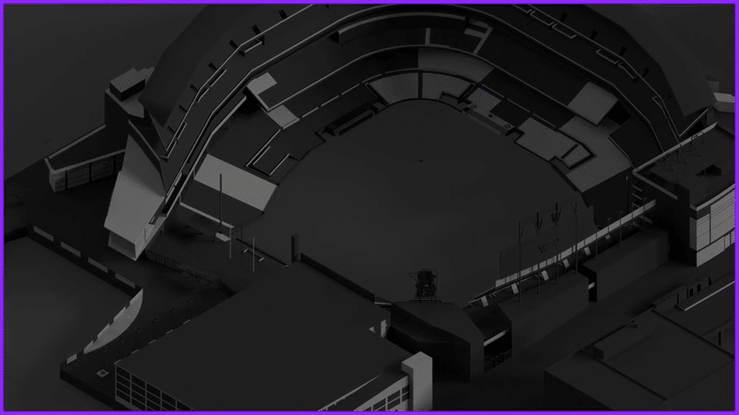
Creating Shared Social Experiences
Let’s be honest: while fans may be physically captive, of a sort, at in-person sporting events, it’s another game to capture and keep their attention. At the same time, sports is inherently social – something that positions it well to beat the AR trap of failing to scale by being mired in individual experiences. Leveraging AR to extend shared moments through every part of the game will help build closer connections between teams, players, and their fans, bringing talent on the field to life in multi-sensory, bigger-than-life arenas.
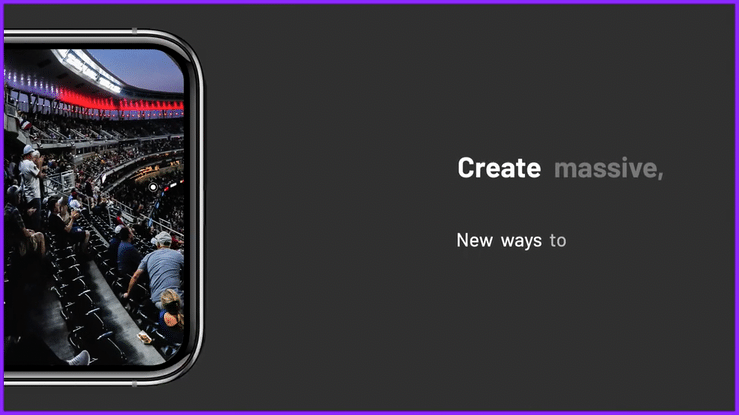
Layering gamified content, player stats and optional replays in AR during games can keep fans focused on and interacting with the field. Brands might stoke team rivalries with interactive competitions during games, with fans’ actions contributing to an aggregate team score. At the end of a game, fans from the winning team might get virtual collectibles or NFTs that build up to larger prizes with more and more engagement at AR-enabled locations, ultimately winning season passes or exclusive IRL merchandise. During intermissions, fans could open their phones to participate in competitions like tug of war fueled by the in-app engagement of 30,000 people, with rival team mascots scaled as AR avatars on the field. You can even imagine beloved mascots like The Phillie Phanatic or Mr. Met swarming the field with AR-doubles for intermission shows that extend beyond the physical to engage fans throughout the entire stadium, not just close to the field.
While our focus is ostensibly on AR moments connected to physical locations and powered by mobile, it’s not hard to see how marketers can activate AR-integrated apps or hardware to plug at-home fans into live sports.
Related
Articles
In the News, Press Releases
Apr 23, 2025
MEET BOBBIE, A NEW INFLUENCER AND CREATOR MARKETING AGENCY
HUNTER, a leading Stagwell (STGW) marketing communications agency, today announced…
In the News, Investments & Financials, Press Releases
Apr 22, 2025
Stagwell (STGW) Announces May Investor Conference Schedule

In the News, Investments & Financials, Press Releases
Apr 17, 2025
Stagwell (STGW) Schedules Webcast to Discuss Financial Results for the Three Months Ended March 31, 2025

Newsletter
Sign Up
Originally released on
by Justin Crann
CONTACT
Beth Sidhu
FEATURING
ARound aims to help brands turn augmented reality from an individual to a communal experience.
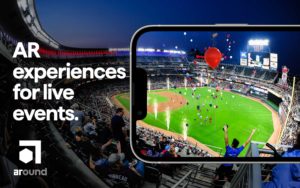
At CES this week, holding company Stagwell debuted a new augmented reality technology it believes will provide a low-barrier entry for many brands and marketers into the metaverse.
The technology, called ARound, is a platform that eschews the often highly individualized AR experience and instead seeks to open it up, allowing venues and retailers to create attractions in the virtual space for their live events, better capturing guests’ attention, personalizing their experiences and increasing brand engagement.
“The purpose of ARound is to change augmented reality from something you do alone in a room with a headset into something you can do as a shared experience, because we believe the most effective experiences for brands, marketers and advertisers are those that are experiential, persistent and shared,” explains Beth Lester Sidhu, chief brand and communications officer with Stagwell.
The technology allows venues, retailers, and others with large spaces that would typically see plenty of traffic to capture that space, build an AR version of it, and then layer different experiences – such as games, direct purchasing, and other interactive elements – on top of it.
As an example, Sidhu cites the MLB mascot race, which typically involves a limited number of participants on an actual baseball field between innings. Rather than being limited to physical space and a small number of participants, teams – including an unnamed franchise which is already employing the ARound platform – can open the experience up to many more participants. H&M was also among the retailers involved in a test conducted last year.
While the applications for the platform are “tremendous,” says Sidhu, “there’s a lot of education.”
“Clients are interested in the product and how they can use it,” she explains. “Marketers want to be at the forefront of what is interesting to consumers, and consumers are excited about AR. But it is hard for most brands to figure out how to play in the space.”
While ARound isn’t a turnkey solution, it is “a scalable way for brands to interact with AR with relative ease and without spending millions of dollars.”
“The power of ARound is in connecting our physical spaces with AR. If we bring those two things together, we can create amazing opportunities for brands, consumers and marketers – really, anybody who wants to be at the forefront,” says Sidhu.
ARound is part of the broader Stagwell Marketing Cloud, which was fully unveiled at CES this year. A suite of integrated SaaS products, it also includes Harris Brand Platform, which provides daily insights on KPIs like brand perception, equity, sales funnels and the impact of marketing campaigns on customer behavior and perceptions; Koalifyed, an end-to-end influencer marketing application; and PRophet, a PR application that uses AI to predict media interest, sentiment and spread of a press story prior to pitching.
Related
Articles
In the News
Apr 24, 2025
WHAT THE DATA SAY: 45% of Gen Z say AI has made college degrees irrelevant
Gen Z says AI has made college degrees irrelevant, according…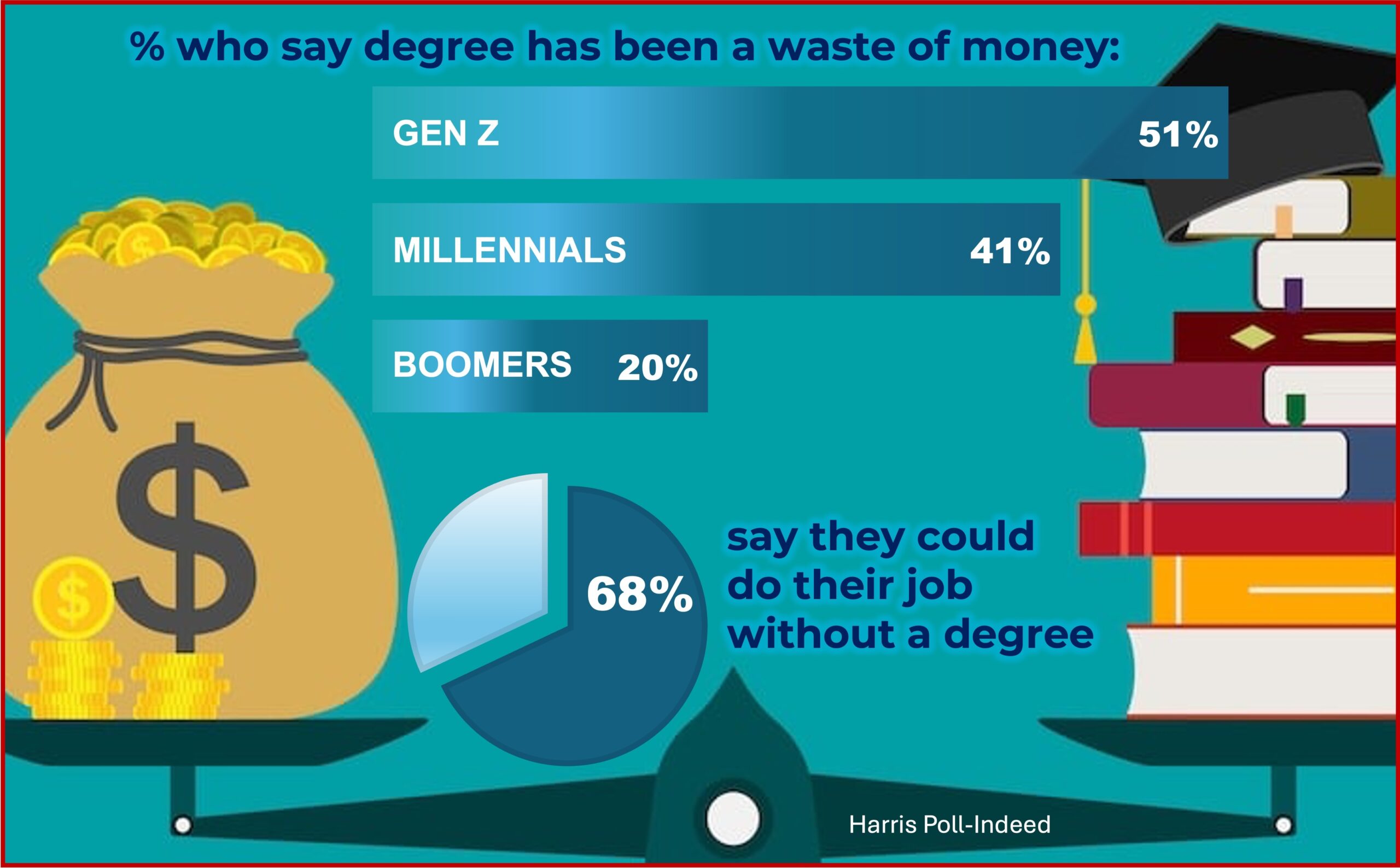
In the News, Press Releases
Apr 23, 2025
MEET BOBBIE, A NEW INFLUENCER AND CREATOR MARKETING AGENCY
HUNTER, a leading Stagwell (STGW) marketing communications agency, today announced…
In the News, Investments & Financials, Press Releases
Apr 22, 2025
Stagwell (STGW) Announces May Investor Conference Schedule

Newsletter
Sign Up
NEW YORK, Dec. 16, 2021 /PRNewswire/ — Stagwell Inc. (NASDAQ: STGW), the challenger network built to transform marketing, today announced its programming and events at CES 2022, including the formal launch of the Stagwell Marketing Cloud. Stagwell’s presence includes a range of activations aimed at decoding what the technologies debuting at CES mean for marketers, brands and consumers, including:
- Stagwell Marketing Cloud Exhibit: The Stagwell Marketing Cloud is debuting at CES via a booth featuring four SaaS products powered by AI, ML and AR. The SMC is a suite of technology products and services that support in-house marketing transformation for modern businesses. Visit booth #CS-10 in the C-Space at Aria.
- Live and Virtual Floor Tours: Led by Stagwell executives from across disciplines and leading technologist Jeff Minsky, Stagwell Media Network Global CEO James Townsend and Stagwell Chief Media Officer Deirdre McGlashan we will take guests on a journey exploring the most compelling technologies being debuted at CES 2022, from the connected home and city to health, sustainability, streaming, and robotics.
- Lunch with Stagwell: Leading practitioners in the areas of digital transformation and media will host two separate luncheons, focusing on how new technologies and tools can elevate brand experiences, from navigating the rise of Web 3.0 to transitioning the structural ways businesses implement technologies.
- CES Cocktails: Hosted in partnership with Brand Innovators, we will convene guests from across industries for cocktails, conversation and the opportunity to reconnect after so long apart.
“Stagwell is launching our the Stagwell Marketing Cloud at CES this year. The Stagwell Marketing Cloud is an innovative suite of products aimed at providing in-house marketers with transformative tools. Incubated by technologists and strategists within Stagwell, we look forward to showcasing the Cloud and demonstrating how the collection of SaaS and DaaS tools can help,” says Mark Penn, Chairman and CEO of Stagwell.
At CES, we will showcase four of products from the Stagwell Marketing Cloud including:
- ARound: An augmented reality creation tool for live events that empowers brand to bring audiences together at scale so they can engage, interact, and socialize in a completely new and meaningful way.
- Harris Brand Platform: A real-time business intelligence application that provides daily insights on brand perception, equity, sales funnels and the impact of marketing campaigns on customer behavior and perceptions.
- Koalifyed: An end-to-end influencer marketing application that brings qualified creators and the world’s top brands together to create credible, engaging content and social experiences that drive connection and culture.
- PRophet: A PR application that utilizes AI and ML to predict media interest, sentiment and spread of a press story prior to pitching, allowing PR professionals to discover new targets and more efficiently pitch and land positive coverage.
For more information or to register for any of Stagwell’s events, please visit: https://stagwellces2022.splashthat.com.
For more information on Stagwell Global and our agency network, please visit www.stagwellglobal.com.
About Stagwell Inc.
Stagwell is the challenger network built to transform marketing. We deliver scaled creative performance for the world’s most ambitious brands, connecting culture-moving creativity with leading-edge technology to harmonize the art and science of marketing. Led by entrepreneurs, our 10,000+ specialists in 20+ countries are unified under a single purpose: to drive effectiveness and improve business results for their clients. Join us at www.stagwellglobal.com.
Media Contact
Beth Sidhu
beth.sidhu@stagwellglobal.com
202-423-4414
SOURCE Stagwell Inc.
Related
Articles
In the News
Apr 24, 2025
WHAT THE DATA SAY: 45% of Gen Z say AI has made college degrees irrelevant
Gen Z says AI has made college degrees irrelevant, according…
In the News, Press Releases
Apr 23, 2025
MEET BOBBIE, A NEW INFLUENCER AND CREATOR MARKETING AGENCY
HUNTER, a leading Stagwell (STGW) marketing communications agency, today announced…
In the News, Investments & Financials, Press Releases
Apr 22, 2025
Stagwell (STGW) Announces May Investor Conference Schedule

Newsletter
Sign Up
ARound brings interactive shared experiences to the metaverse.
NEW YORK, Dec. 16, 2021 /PRNewswire/ — Stagwell Inc. (NASDAQ: STGW) announced today it will launch an innovative, location-based augmented reality platform, ARound, bringing shared experiences to live events and the retail space by engaging audiences through connected interactions in the metaverse. Stagwell will unveil and demo ARound at CES 2022, within its CES booth #CS-10 in the C-Space at Aria and during CES Unveiled on January 3 at Mandalay Bay and Pepcom Digital Experience on January 4 at The Mirage.
ARound helps venues and retailers create AR attractions for live events, bringing audiences together at scale where they can play, interact, and socialize in completely new and exciting ways. Stadiums and sports teams can now engage casual fans or customers by recapturing their attention and personalizing their experiences. Retail consumers will benefit from a more connected, immersive community experience that increases brand engagement.
“Until now, AR has focused on the individual – but ARound recognizes that the best connections come from shared experiences that connect individuals to the world around them,” said Josh Beatty, ARound founder and CEO. “Location-based AR is a relatively new and evolving space, and spatial computing represents the next major computing innovation – one that will focus less on the way we receive information and more on the way we connect with what is around us. While devices often cause distraction, ARound enables users to be more present at events, connecting people and places through shared technology.”
“Consumers have lost patience for boring, impersonal, and disconnected marketing. And the race for their attention in today’s digital marketplace couldn’t be tighter,” said Mark Penn, Chairman and CEO, Stagwell. “ARound offers clients an opportunity to chart a new course in a powerful – and fast growing – dimension of consumer experiences. We’re proud to support Josh as he works to bring the product to life,” said Mark Penn, Chairman and CEO, Stagwell.
ARound is currently being trialed by global retailer H&M, as well as a Major League Baseball team at their stadium. More partners will be announced early next year.
ARound is the newest product from the Stagwell Marketing Cloud, Stagwell’s growing suite of technology products and services that support business transformation for modern marketers. It was developed as the winning idea at Stagwell’s annual innovation competition, which challenges teams to pitch new product ideas to modernize marketing services and pre-empt the needs of tomorrow’s leading brands. As a winner, ARound received capital and resources from Stagwell to build and launch the product as well as ongoing executive mentorship from the company’s marketing and technology services leaders.
Stagwell Marketing Cloud – powered by a global workforce of 1000+ engineers – arms modern marketers with a toolbox of capabilities spanning influencer marketing, audience segmentation, AI-powered communications tech, competitive brand intelligence and cutting-edge technology in the developing spaces of AI, ML, AR/VR, data processing and fraud detection. Stagwell’s products include Koalifyed, CUE, PRophet, Harris Brand Platform, Telephia, Truly Social, Stage, and Navigator.
To schedule a product demo of ARound at Stagwell’s CES booth, #CS-10, contact (brand@stagwellglobal.com). To schedule a media interview with AR founder, Josh Beatty, contact Pam Golden at pam@GLAPR.com.
About Stagwell Inc.
Stagwell is the challenger network built to transform marketing. We deliver scaled creative performance for the world’s most ambitious brands, connecting culture-moving creativity with leading-edge technology to harmonize the art and science of marketing. Led by entrepreneurs, our 10,000+ specialists in 20+ countries are unified under a single purpose: to drive effectiveness and improve business results for their clients. Join us at www.stagwellglobal.com.
Media Contact
Beth Sidhu
beth.sidhu@stagwellglobal.com
202-423-4414
SOURCE Stagwell Inc.
Related
Articles
In the News, Press Releases
Apr 23, 2025
MEET BOBBIE, A NEW INFLUENCER AND CREATOR MARKETING AGENCY
HUNTER, a leading Stagwell (STGW) marketing communications agency, today announced…
In the News, Investments & Financials, Press Releases
Apr 22, 2025
Stagwell (STGW) Announces May Investor Conference Schedule

In the News, Investments & Financials, Press Releases
Apr 17, 2025
Stagwell (STGW) Schedules Webcast to Discuss Financial Results for the Three Months Ended March 31, 2025




